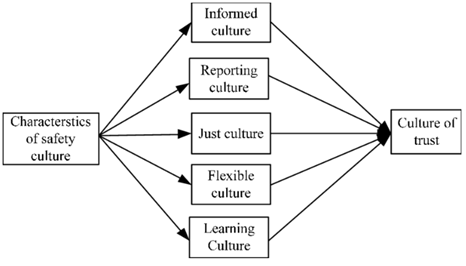 Whenever Safety puts conditionality on culture is no longer talks about Culture but rather the adjective that qualifies thinking about culture. We see this with the work of Reason who applied 5 adjectives to define a culture of safety. These are: ‘reporting’, ‘informed’, ‘learning’, ‘just’ and ‘flexibility’. Of course, Reason doesn’t define justice or learning and so makes the ‘dimensions’ conditional on how one considers culture.
Whenever Safety puts conditionality on culture is no longer talks about Culture but rather the adjective that qualifies thinking about culture. We see this with the work of Reason who applied 5 adjectives to define a culture of safety. These are: ‘reporting’, ‘informed’, ‘learning’, ‘just’ and ‘flexibility’. Of course, Reason doesn’t define justice or learning and so makes the ‘dimensions’ conditional on how one considers culture.
In reality, none of this supposed model or dimensions are about culture. Whenever an adjective is applied to a noun it makes the adjective the qualifier of the noun. The adjective is dominant because it describes the nature of the noun. Each adjective Reason applies to culture then become a reductionist approach to try to control culture through definition and branding. This is why Safety loves Reason so much and always cites Reason whenever safety is discussed.
Even when Reason uses language of ‘just’ and ‘learning’ there is complete silence on justice and the learning. What Reason talks about when he uses the word ‘learning’ is about training and indoctrination, it’s not about learning. Similarly, Reason confuses the language of ‘just’ for ‘Justice’ and even uses absurd language like ‘Engineering a Just Culture’ (1997. p.205). Only Safety could make up such complete nonsensical ‘goop’.
There is no relationship between an understanding of culture and the worldview of engineering. Any suggestion that culture can be ‘engineered’ or ‘constructed’ (eg. Hopkins, Cooper) is nonsense.
The same for silly language about culture being a ‘product’.
This also applies for Hollnagel’s nonsense about Resilience Engineering (https://safetyrisk.net/why-resilience-cannot-be-engineered/; https://safetyrisk.net/an-social-ecology-of-resilience/) and makes as much sense as S1 and S2. There is no ‘safety differently’, it’s just a brand for the same methods, the same doing.
Most of Reason’s models and thinking is reductionist and linear, the worst being the infamous Swiss-cheese. The Swiss-cheese model is one of the most dangerous creations of Reason, because it doesn’t reflect reality. Life and living, events and accidents are rarely linear. Life is messy, unpredictable and wicked (https://safetyrisk.net/risk-and-safety-as-a-wicked-problem/). By manufacturing this reductionist and linear construct Reason has provided Safety with the outcome it so desires, but it isn’t real.
Reason’s symbology and myths are not real but rather a construct imposed on reality to try and control it.
Whilst some myths, rituals and symbols are helpful, Reasons are not.
Hey but don’t critique Reason, the sacred cow of Safety (https://safetyrisk.net/a-critique-of-pure-reason/).
This is how Safety imposes its many constructs on reality. Heinrich is another example. Yet, here we are with Safety falling ‘hook, line and sinker’ for a model of injury rates made up like a fairy tale. Only Safety could fall for the concoction of an insurance salesman and make it as symbolic myth. Similarly, Heinrich’s dominoes (p.15), the foundation for the Swiss-cheese.
In reality what we have is an industry in love with behaviourism and engineering finding models to suit its worldview.
None of this is ‘scientific’ as proposed by Heinrich, it’s all a fiction of his imagination. It doesn’t reflect reality. There is no ratio of injury and even then, framing safety by injury is nonsense.
This is what Safety does with the messy and disorderly nature of life and being. See Figure 1. Messy and Figure 2. Imposed Structure.
Figure 1. Messy
Figure 2. Imposed Structure
This is what Reason does with constructing 5 dimensions of culture and the Swiss-cheese.
What Safety does is actually create the confusion about culture that it loves to complain about (https://safetyrisk.net/on-culture-and-safety/).
No wonder Safety says its confused about culture (https://safetyrisk.net/no-wonder-safety-is-confused-about-culture/). No wonder Safety doesn’t want to talk about culture in books it writes about culture.
All this assertion that Safety makes about culture being ‘cloudy’, ‘foggy’, ‘abusive’ and ‘confusing’ is a concoction of its own making. It says much more about the worldview of Safety than it does about culture. And all of this concoction is based on the addiction of Safety to zero, measurement, hazards and control. If Safety could break the addiction to this stuff no doubt safety would improve. Even in the latest Code of Practice on psychosocial issues poor olde safety uses the language of ‘hazard’ to describe them. No-one in a profession associated with psychosocial or mental health issues would use the dumb word ‘hazard’ when speaking of situations or conditions/challenges in mental health. It is a recipe for demonising and brutalising persons. It is essentially unethical language. But back to Reason.
I find nothing in Reason that helps provide practical, positive and constructive approaches to the reality of risk or the complexities of culture. Reason’s models are misleading at best and dangerous at worst.
If you are interested in moving away from these traditional constructs and models you might be interested in two free courses being offered next year in SPoR.
Free Modules in Culture and Safety
So, for those who are able and willing to suspend their own assumptions and framing in knowing, there are ways of understanding culture that can be learned, outside of the safety paradigm. First, a great deal has to be unlearned (stepping away from engineering and behaviourism) and letting go of the safety paradigm, in order to move forward to a different way of knowing.
The first rule of culture is to make sure you talk about culture; the second rule of culture is to talk about it outside of the safety paradigm.
If this module is of interest and you are seeking an understanding of culture and the culture of safety, Dr Long will be conducting a free Module on Culture and safety in 2023. It’s easy to register for this free program, by just send an email to robertlong2@mac.com and you will be put in the list.
The module will run Zoom sessions every Tuesday at 9am (Canberra time) starting on 21 February 2023 and with 90-minute sessions at 9 am and each following Tuesday at 9 am for 5 weeks. So, this means 5 consecutive sessions on the topic. This means that the last session will be on 21 March 2023.
Do NOT register for this program simply because it is free. Register if you think you are ready to let go and learn.
Those interested can start by reading Dr Long’s blogs on culture and culture silences:
· https://safetyrisk.net/category/safety-culture-3/
· https://safetyrisk.net/category/safety-culture-silences/
Similarly, it will be helpful to read some of Lotman:
· The Unpredictable Workings of Culture
· Universe of the Mind, A Semiotic Theory of Culture
Or Bachelard:
· https://sites.evergreen.edu/wp-content/uploads/sites/88/2015/05/Gaston-Bachelard-the-Poetics-of-Space.pdf
Second Free Module – An Ethic of Risk
The second free module on offer is module 17 (https://cllr.com.au/product/an-ethic-of-risk-unit-17/) on Ethics and Risk.
The module will run Zoom sessions every Tuesday at 9am (Canberra time) starting on 28 March and with sessions at 9 am and each following Tuesday at 9 am for 5 weeks. So, this means 5 consecutive sessions on the topic. This means that the last session will be on 25 April.
Registrations for this Module close on 3 February.
Dr Long will create a common list from registrations and will communicate with the group about watching videos and pre-reading.
Please DO NOT register for a course just because it is free.
Both programs are positive, constructive, practical and help with skills in tackling risk.





Rob long says
Brian, once people are indoctrinated into the traditional safety curriculum they assume they have been taught sone kind of truth. Mostly because the curriculum is supported by the regulator and associations. There is a great deal of sink cost in this.
The trouble is most of it is a delusion, and is no protection. The trouble is the cost of cognitive dissonance is so painful that they will defend the delusion until they die even though there is not much in what they do that is humanising, liberating or creative.
Brian Edwin Darlington says
Hi Rob, you are so right, many safety persons are not willing to change, I posted the iCue Causation model and some traditionalists hammered it. Some will never change, however we work with those that see the need to change to SPoR.
Risk Culture Builder says
Sometimes risk and safety management suffers from ADD
Rob Long says
What an absurd concept to use the notion of ADD in application to risk. Obviously from a source with no expertise or experience in mental health issues. The correlation is nonsense.
Matt Thorne says
Looking. forward to meeting a bunch of people on their SPoR adventure!
Rob Long says
Yes Matt, lots of new people signing in from across the globe. Will be a great time of unlearning and learning.